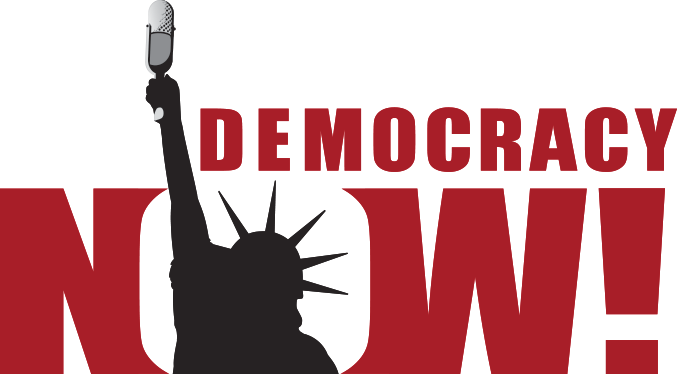
Tension between immigration agents and community activists is growing in Chicago, where ICE agents have deployed tear gas and pepper balls against ongoing protests outside Chicago’s Broadview ICE detention facility.
Democracy Now! speaks with community activist Cristóbal Cavazos, who says that the people of Chicago have been steadfast in their mobilization against ICE, with communities engaging in daily protests and community safety patrols. “We’re really doing some historic mobilization here in Chicago, and we’re super proud,” says Cavazos. “The key word here is 'resistance.'”
Transcript
AMY GOODMAN: We end today’s show in Chicago, where Trump’s Border Patrol chief, Gregory Bovino, joined Border Patrol agents in tactical gear who roamed downtown streets and rode boats in the Chicago River. On Monday, Illinois Governor JB Pritzker condemned ICE’s violent attacks and confirmed the so-called Department of War was seeking the deployment of a hundred military troops to Illinois.
GOV. JB PRITZKER: Sixty percent of the individuals that ICE has taken in Illinois this year have no criminal convictions of any kind. ICE is running around the Loop harassing people for not being white. Just a year ago, that was illegal in the United States. Now ICE is making it commonplace.
AMY GOODMAN: For more, we’re joined in Chicago by Cristóbal Cavazos, longtime community activist, who’s been volunteering with people’s patrols of ICE. He’s co-founder of Immigrant Solidarity DuPage and Casa DuPage Workers Center.
Welcome to Democracy Now!, Cristóbal. Explain what’s taking place and how you are organized and what these people’s patrols of iCE are.
CRISTÓBAL CAVAZOS: Good morning, Amy. It’s really a pleasure to be here.
So, we’re seeing a historic onslaught in Chicago, the killing of Silverio Villegas González. We’re seeing it at Broadview detention center, friends of mine who have been tear-gassed, people being thrown like pancakes, ICE in the Loop, ICE going down the Chicago River on boats. It’s really an attack on Chicago. They’re trying to break our spirit. It was noted a few months ago by Tom Homan that, you know, Chicago, your rights and your rights and your rights. And it’s true.
We’ve been, in Chicago, organizations like Casa DuPage, educating people, doing workshops, doing community patrols, doing rapid response. So, Chicago has been — you know, we’re the City of Big Shoulders, but we’re showing we’re the city of a big struggle, too. The people’s patrol, we have people all over Chicagoland, that it’s been a really beautiful mobilization. How can I help? You know, what can I do right now in the face of ICE? What can I do with the attacks?
Cities like Elgin, Illinois — they are our dear brothers and sisters — have been attacked almost every single day. And we are really mobilizing people. There are men, women, people from the Anglo community, African American community, Asian brothers and sisters coming out and giving a half an hour, an hour every single day, patrolling our neighborhoods, giving out Know Your Rights cards, talking to people in Mexican stores, Mexican lavandería — you know, Chicago is a very Mexican town — making these contacts, but at the same time creating these networks of protection, these networks of resistance, and in the face of ICE.
You know, we have ICE in places like Elgin and Joliet and Aurora, but being chased by three or four cars, ICE. I ran into ICE two weeks ago. Three of our protesters, protesting ICE, shouting at them, ”ICE.” ICE left. They don’t like this. And now I don’t think it’s a coincidence they’re trying to send in a hundred federal troops to protect ICE. But I think, you know, we’re having an historic attack right now, as we see, but there’s also historic fightback.
JUAN GONZÁLEZ: And, Cristóbal, I wanted to ask you — you mentioned you’re in DuPage County, but the vast majority of the Latino and immigrant population of Chicagoland is not in the city. It’s in places like, you mentioned, Aurora, Waukegan, Elgin, Cicero. These are all majority-Latino cities. What has been the nature of the organizing in these areas outside of Chicago?
CRISTÓBAL CAVAZOS: Yeah, that’s exactly right, hermano. It’s good to hear your voice, Juan.
Yeah, you know, Chicago, a lot of people forget Chicago, we’re right up there in food production, beverage production, and it’s our people that — you know, my parents were migrant workers — the food in Chicago, the beverages in Chicago. So, a lot of that production is in places like Elgin, Bartlett, Elk Grove Village, Illinois. So we have a lot of workers, ironically, workers that, you know, five years ago, essential workers, factories giving them — you know, lauding them and thanking them. And now these so-called essential workers are illegal workers. So it really makes no sense.
So, we’re trying to go in there, in these factories, putting safety committees, you know, having a sticker on the door that ICE cannot come in without a judicial warrant. As we’re seeing in Chicago, they rarely have judicial warrants. That’s why they’re trying to do this war of terror, you know, going out there and just going on Michigan Avenue and trying to freak people out and instill this paranoia. But we, as organizers, you know, we’re trying to keep that strength. We’re trying to keep that solidarity.
So, we’re doing factory committees for safety. We’re patrolling outside of these factories. West Chicago, which is a town that’s close to where we organize, people are actually doing patrols where they stand outside apartment buildings. They’ll be there for hours every day, until midnight, 1:00 or 2:00 in the morning, patrolling these apartment buildings, and, if ICE is there, immediately intervening, immediately getting — you know, doing a protest, letting people know. So, we’re really doing some historic mobilization here in Chicago, and we’re super proud. But we know we’re in the thick of it right now, and, you know, the key word here is “resistance.”
JUAN GONZÁLEZ: And we only have about less than a minute left, but the — Trump’s threats to send federal troops to Chicago, he’s continued to back down and back down. Now he’s talking about a hundred troops. What is your sense of how Chicago would respond if federal troops are sent in?
CRISTÓBAL CAVAZOS: Yeah, I think, you know, Trump has really done a propaganda war. He’s just trying to freak us out, a hundred troops. I mean, there are 3 million people in Chicago. There are hundreds of thousands of people in the Latino community. So, he’s trying to scare us. He’s trying to build a lot of fear in the community to stop us from fighting back. But, you know, frankly, it’s not going to work. We’re going to go out there. I know he’s sending these troops, because, you know, we routinely in Chicago have ICE agents surrounded by protesters. We’re shouting them out. We’re calling them out. We have congresspeople, aldermen in Chicago that are standing up to ICE. So, he’s going to send in these troops. But I think, as all of the attacks in Chicago have done, it’s had an opposite effect, in that it’s stimulating the movement. It’s stimulating. There’s going to be a protest today at 5:00 at Trump Tower. And we’re not going to back down.
AMY GOODMAN: Cristóbal Cavazos, we want to thank you for being with us, people’s patrol volunteer in Chicago. Thank you very much for being there. Tomorrow, we’ll speak with Chicago’s mayor.
Coming up this weekend, I’ll be speaking Saturday, October 4th, at the Roxie Theater in San Francisco, doing the Q&A after the JFI special documentary screening of Steal This Story, Please, a new documentary about Democracy Now! That’s at 4:00 on Saturday. And on Sunday, I’ll be at BAMPFA in Berkeley for another screening and Q&A. I’m Amy Goodman, with Juan González.













Media Options